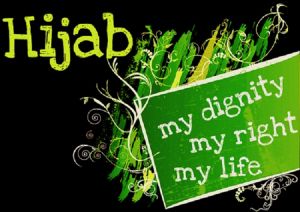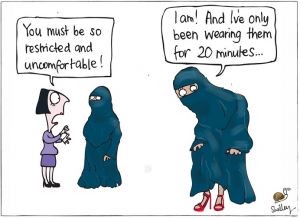The Islamic Dress Code Islam is a complete way of life, each and every aspect is designed by our Creator to advance happy, healthy communities and ease the path to eternal bliss in Paradise. In today's society modesty is seen as a sign of weakness or insecurity. This is not the case in Islam, where modesty is seen as a sign of respect for oneself and others. The modesty that every human being is born with is seen as something to be treasured. To this end Islam has a dress code for both women and men. Its purpose is to protect the society as a whole and promote modest dressing and behaviour. It creates a barrier between the sexes and allows us to conduct our lives with modesty, dignity and respect.
Islam is a complete way of life, each and every aspect is designed by our Creator to advance happy, healthy communities and ease the path to eternal bliss in Paradise. In today's society modesty is seen as a sign of weakness or insecurity. This is not the case in Islam, where modesty is seen as a sign of respect for oneself and others. The modesty that every human being is born with is seen as something to be treasured. To this end Islam has a dress code for both women and men. Its purpose is to protect the society as a whole and promote modest dressing and behaviour. It creates a barrier between the sexes and allows us to conduct our lives with modesty, dignity and respect.
Islam holds women in very high esteem and the Islamic rules of covering are intended to protect and guard her dignity and honour. The word used most often in regard to covering is hijab. All qualified Muslim scholars throughout the history of Islam agree that fulfilling the conditions of the dress code is an obligation on all Muslim men and women. They have based these conditions on evidence found in the Quran and the Sunnah. Below are the most well known verses of the Quran and the most well known saying from the Prophet Muhammad concerning the subject of hijab.
The Virtues of Hijab 1. An act of obedience.
1. An act of obedience.
The hijab is an act of obedience to Allah and to his prophet (peace and blessings be upon him), Allah says in the Quran:
"It is not for a believer, man or woman, when Allah and His messenger have decreed a matter that they should have an option in their decision. And whoever disobeys Allah and His Messenger (peace and blessings be upon him), has indeed strayed in a plain error." [Noble Quran 33:36]
Allah also said: "And tell the believing women to lower their gaze (from looking at forbidden things) and protect their private parts (from illegal sexual acts, etc) and not to show off their adornment except what must (ordinarily) appear thereof, that they should draw their veils over their Juyubihinnah." [Noble Quran 24:31]
Juyubihinnah: The respected scholars from As-Salaf As-Saleh (righteous predecessors) differed whether the veil cover of the body must include the hands and face or not. Today, respected scholars say that the hands and face must be covered. Other respected scholars say it is preferable for women to cover their whole bodies.
The Question of Hijab: Suppression Or Liberation? "Why do Muslim women have to cover their heads?" This question is one which is asked by Muslim and non-Muslim alike. For many women it is the truest test of being a Muslim.
"Why do Muslim women have to cover their heads?" This question is one which is asked by Muslim and non-Muslim alike. For many women it is the truest test of being a Muslim.
The answer to the question is very simple - Muslim women observe HIJAB (covering the head and the body) because Allah has told them to do so.
"O Prophet, tell your wives and daughters and the believing women to draw their outer garments around them (when they go out or are among men). That is better in order that they may be known (to be Muslims) and not annoyed..." [Noble Quran 33:59]
Other secondary reasons include the requirement for modesty in both men and women. Both will then be evaluated for intelligence and skills instead of looks and sexuality. An Iranian school girl is quoted as saying, "We want to stop men from treating us like sex objects, as they have always done. We want them to ignore our appearance and to be attentive to our personalities and mind. We want them to take us seriously and treat us as equals and not just chase us around for our bodies and physical looks." A Muslim woman who covers her head is making a statement about her identity. Anyone who sees her will know that she is a Muslim and has a good moral character. Many Muslim women who cover are filled with dignity and self esteem; they are pleased to be identified as a Muslim woman. As a chaste, modest, pure woman, she does not want her sexuality to enter into interactions with men in the smallest degree. A woman who covers herself is concealing her sexuality but allowing her femininity to be brought out.
The Obligatory Conditions For An Islamic Hijab 1. Covering ALL Of The Body
1. Covering ALL Of The Body
It is an agreed position by many respected scholars that the face and hands of the woman must be covered. Some scholars say it is permissible to uncover the face and the hands of the woman as long as there is no fitnah (infatuation) caused by this action. Two things must be taken into consideration
If she is beautiful and beautifies her face and hands with external substances, or
The society around her is corrupt where men do not lower their gaze, then it is prohibited for her to uncover her face and hands.
On the authority of the wife of the prophet (peace and blessings be upon him), Umm Salamah said:
"When the verse was revealed that they should cast their outer garments over their bodies' was revealed, the women of Ansar came out as if they had crows over their heads by wearing outer garments.
The Hijab as Da'wah  Most Muslims are familiar with the various reasons that Allah has required women to wear hijab: The hijab reflects modesty, purity and respect; it lessens temptation so that more serious sins will be avoided; it protects women from the harm and molestation of evil men; a woman who wears hijab will be evaluated for her intelligence and skills rather than her appearance. One important aspect that is often overlooked, however, is that the hijab is a symbol of Muslim identity. A woman who covers her head is making a statement that she is a member of the Muslim community and that she follows a particular code of moral conduct.
Most Muslims are familiar with the various reasons that Allah has required women to wear hijab: The hijab reflects modesty, purity and respect; it lessens temptation so that more serious sins will be avoided; it protects women from the harm and molestation of evil men; a woman who wears hijab will be evaluated for her intelligence and skills rather than her appearance. One important aspect that is often overlooked, however, is that the hijab is a symbol of Muslim identity. A woman who covers her head is making a statement that she is a member of the Muslim community and that she follows a particular code of moral conduct.
Allah says: "O Prophet, tell your wives and daughters and the believing women to draw their outer garments around them. That is more suitable that they will be known (as Muslims and chaste believing women) and not be abused." [Qur'an, 33:59]
"...that they will be known..." In America, where Islam is the fastest growing religion (alhumdullilah), many people are coming to know what this head covering really signifies and to understand the religion that mandates it. The hijab, in effect, is an amazingly powerful tool for dawah; one that Muslims themselves are probably not even aware of. As with any tool, the key for effectiveness is appropriate and knowledgeable use.
